![]()
![]()
![]()
Use LEFT and RIGHT arrow keys to navigate between flashcards;
Use UP and DOWN arrow keys to flip the card;
H to show hint;
A reads text to speech;
66 Cards in this Set
- Front
- Back
- 3rd side (hint)
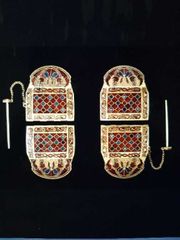
|
Hinged Shoulder Clasp, Sutton Hoo Ship Burial, Suffolk, England, c. 625 CE |
|
|
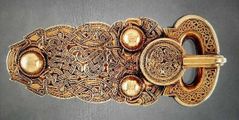
|
Belt Buckle, mound 1, Sutton Hoo Dhip Burial, Suffolk, England, c. 625 CE |
|
|
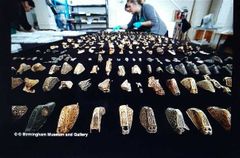
|
Staffordshire Hoard (various objects), Hammerswitch, 7-8th centuries CE |
|
|
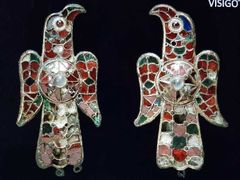
|
Eagle fibulae, Visigothic Spain, 6th century CE |
|
|
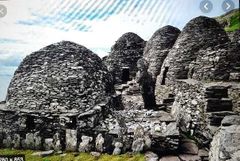
|
Skellig Michael Monastery, Ireland, 6th to 9th centuries |
|
|
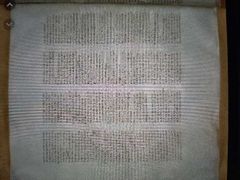
|
Codex Sinaiticus, Eastern Mediterranean, 350 CE |
|
|
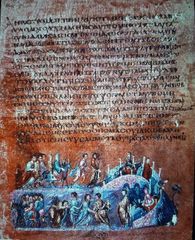
|
The Story of Jacob, Vienna Genesis, Syria/Palestine, Early 6th century CE |
|
|

|
Symbol of St. Matthew, Book of Durrow, Durrow, Second half of 7th century |
|
|

|
Carpet Page, Lindisfarne Gospels, Lindisfarne, c. 710-725 CE |
|
|
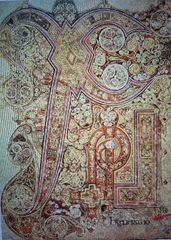
|
Chi Rho Iota Monagram, Book Of Kells, Iona, c. 750-825 CE |
|
|
|
Cloisonné enamel |
Technique using cells made from thin wire, then soldering them to metal backing to create enclosed shapes for enamel (or melted jewels or glass) to be poured into |
|
|
|
Millefiori |
A glass/enamel technique where thin rods of coloured glass are gathered like a bouquet to create a pattern at the base, then cut into little tiles to be placed in jewelry or other pieces |
Means: a thousand flowers |
|
|
Zoomorphic |
Depicting animals, or having animal characteristics |
|
|
|
Anthropomorphic |
Having human characteristics |
|
|
|
Niello |
Technique using a black mixture of sulfur, silver, lead and copper to fill in engraved designs in metals like silver |
|
|
|
Apotropaic |
Having a protective nature, and repels evil or bad luck |
Associated with knotwork/unbroken line |
|
|
Dry-stack method |
Constructing a wall by stacking cut stones without any binding agent like mortar |
Associated with Hadrian's Wall |
|
|
Hiberno-Saxon |
Art style that came from post-Roman Ireland and England |
|
|
|
Scriptorium |
A room in a monastery used by scribes to write, copy and illuminate manuscripts |
|
|
|
Codex |
A bound handwritten manuscript |
|
|
|
Parchment and vellum paper |
Parchment: made from sheep, calf or goat skin Vellum: finer quality and made from young animal's skin (calf or lamb) |
|
|
|
Illumination vs illustration |
Illustration: explaining the text with relevant paintings Illumination: use of silver and gold leaf or powder to give the illusion of illumination, and was decorative and embellished capital letters, margins and borders |
|
|
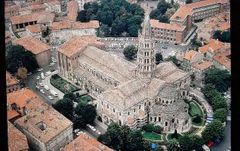
|
Saint-Sernin Cathedral, Toulouse, ca. 1070-1120 CE |
|
|
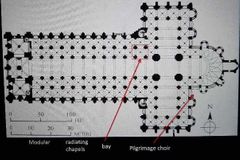
|
Saint-Sernin Interior plan |
|
|
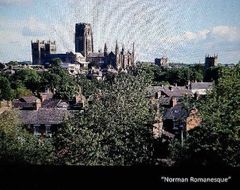
|
Durham Cathedral, Durham, England, ca.1093-1133 CE |
Norman Romanesque |
|

|
Maiestas Domini Tympanum (south portal), Saint-Pierre, Moissac, c. 1115-1130 CE |
|
|

|
Giselbertus, The Last Judgment Tympanum (west portal), Cathedral of Saint-Lazare, Autun, c. 1120-1145 CE |
|
|
|
Bay |
Vertical division of a church that encloses 4 piers or pillars that supports a groin or rib vault |
|
|
|
Romanesque pilgrimage choir |
The east end of a romanesque church, encompassing the apse, ambulatory and radiating chapels, all serving to allow for a large crowd of pilgrims |
|
|
|
Compound pier |
A pier, or large pillar, with a group or cluster of pilasters attached to its outer surface |
|
|
|
Barrel Vault |
A semicircular arched ceiling |
|
|
|
Radiating chapel |
Smaller chapels that surround the apse, with altars where relics could be placed |
|
|
|
Quadrant arch |
Buttress under the roof, over the tribunes, for massive nave piers |
In Durham Cathedral |
|
|
Transverse arch |
An arch that goes from side of a vault to the other |
|
|
|
Nave colonnade |
A row columns or pillars that go down each side of the nave |
|
|
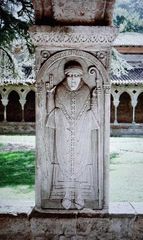
|
Durandus, Marble relief on cloister pier, Abbey of saint-Pierre, Moissac, c. 1100 CE |
|
|
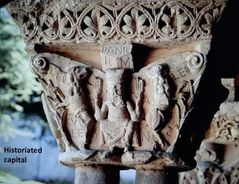
|
Daniel in the Lion's Den, historiated capital, Monastery of Saint-Pierre, Moissac, c. 1100 CE |
|
|
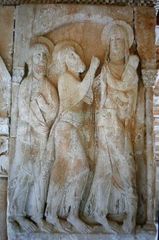
|
Road to Emmaus, Monastery of Santo Domingo de Silos, c. 1100 CE |
|
|

|
Benedictine Monastery of Cluny Plan (Cluny 2, 11th century, Cluny 3, 12th century) |
|
|
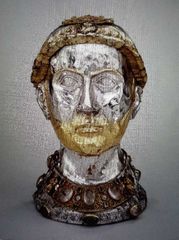
|
Reliquary Bust of Saint Yrieix, Limousin, 1225-1250 CE |
|
|
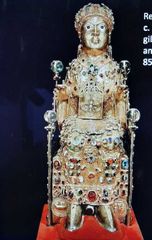
|
Reliquary Effigy of St-Foy, Conques, c. 1000 CE |
|
|

|
Arm reliquary of St-Peter, South Netherlands, c. 1230 CE |
|
|

|
Abbey Church at Fontenay, 1139-1147 CE |
Cisterian order |
|
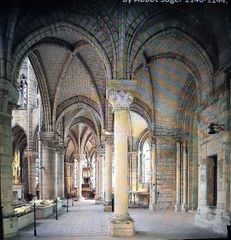
|
Chevet of Abbey Church of Saint Denis, north of Paris, rebuilt by Abbott Suger c. 1140-1144 |
|
|
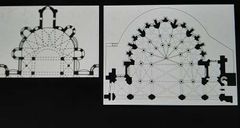
|
Plan of Romanesque Pilgrimage Choir of Saint Sernin vs Chevet of Saint Denis |
|
|
|
Relic |
Part of the body of a Saint or religious figure Contact relic: object touched or used by saint, or textile worn or kept near by deceased saint |
|
|
|
Reliquary |
Heavily adorned container for a relic |
|
|
|
Claustrum |
A covered passage that surrounds an open square and gives access to multiple buildings within the monastery. A primary place for reading and instructing |
|
|
|
Historiated capital |
A capital atop a pillar decorated with relief carvings, sometimes depicting a narrative |
|
|
|
Virtus |
The strength given to relics, and power of saintly bodies |
Latin for strength |
|
|
Furta Sacra |
The phenomenon of relic theft. It was commonplace and almost acceptable because of belief that the relic "allowed" itself to be stolen, therefore it's new location is where it's meant to be |
|
|
|
Benedictine order |
ex: Benedictine Abbey of Cluny was founded by William I who renounced any claim to establishment; it was entirely up to monks how to run it, and they were given many donations. Which allowed for extravagance and opulence in monastery |
|
|
|
Cistercian order |
Response to benedictine order, a reform and return to modesty in churches and monasteries |
|
|
|
Apoligia |
A written defence of ones opinions (ex: Bernard de Clairvaux's apologia to William of St-Thierry: his opposition to opulence in places of worship) |
|
|
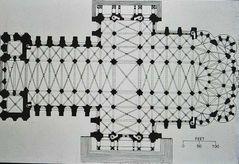
|
Chartres Cathedral, Chartres interior rebuilt (after fire) 1194 CE |
|
|
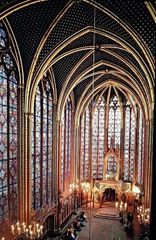
|
Interior of Upper Chapel, Sainte-Chapelle, Paris, 1239-1248 CE |
|
|
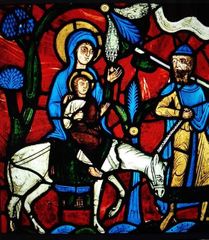
|
Flight into Egypt (stained glass), Abbey Church of Saint Denis, c. 1140-1144 CE |
|
|
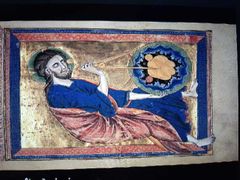
|
God as creator of the world, Frontispiece of a moralized bible, Paris, ca. 1220-1230 CE |
|
|
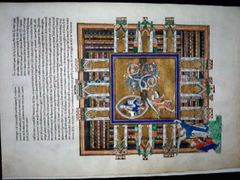
|
Heavenly Jerusalem, folio from trinity college apocalypse, Anglo-norman, 1255 CE |
|
|
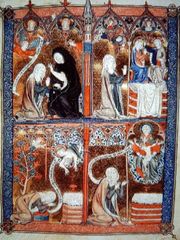
|
A nun experiences three stages of mystical vision, Paris, c.1310 CE |
|
|
|
Quadripartite ribbed vault |
A vaulting system with 2 diagonal intersecting ribs connecting from one transverse arch to the other, creating 4 areas of webbing |
|
|
|
Pseudo-Dionysius |
Christian theologian, believed in Neo-platonic philosophy that describes emanation from immaterial to material form. (So: support of opulence in places of worship) |
Abbot Suger believed he was the reembodiment of Saint Denis |
|
|
Flying buttress |
An exterior arch support that attaches the roof line to the buttress pier |
|
|
|
Glazier |
A special class of glass workers that would create a stained glass window |
|
|
|
Scholasticism |
The application of Aristotle's principles to the interpretation of religious belief; the belief that logic and reason can also lead to religious truth |
|
|
|
Rose window |
Large stained glass window above main altar with stone ornamented tracery to suggest a flower design |
|

